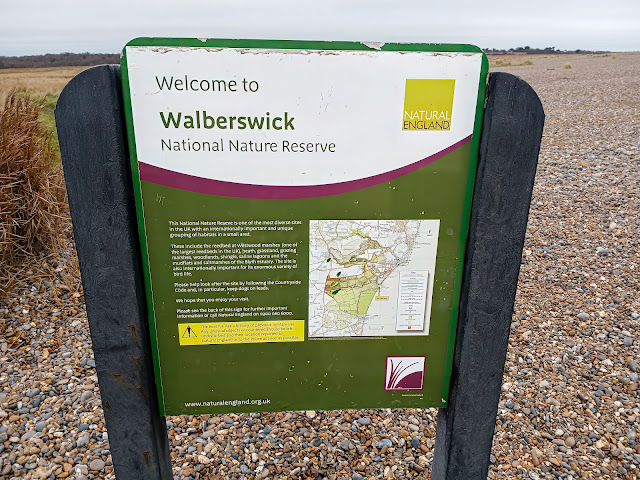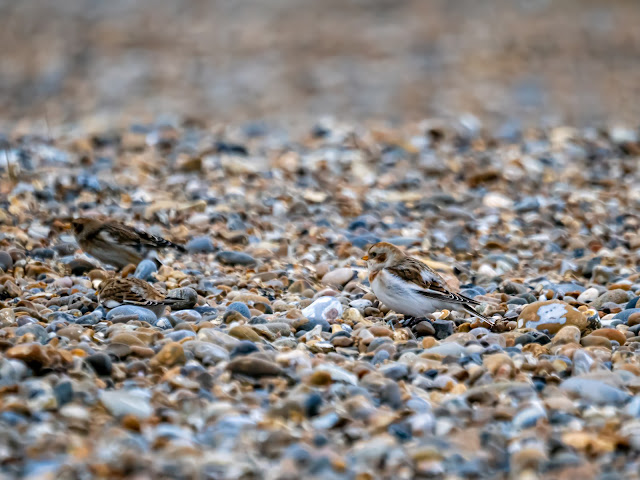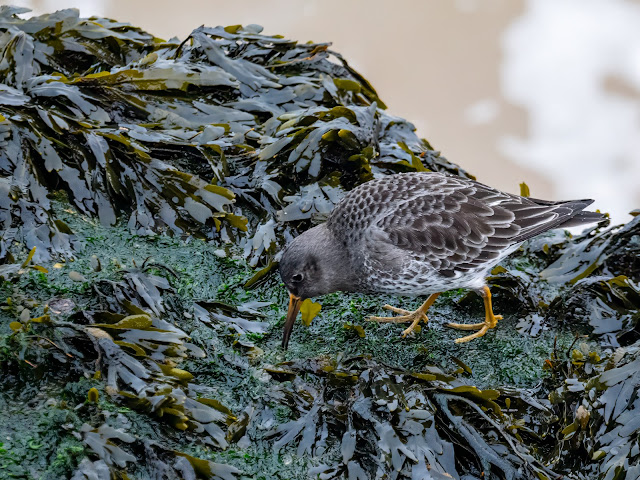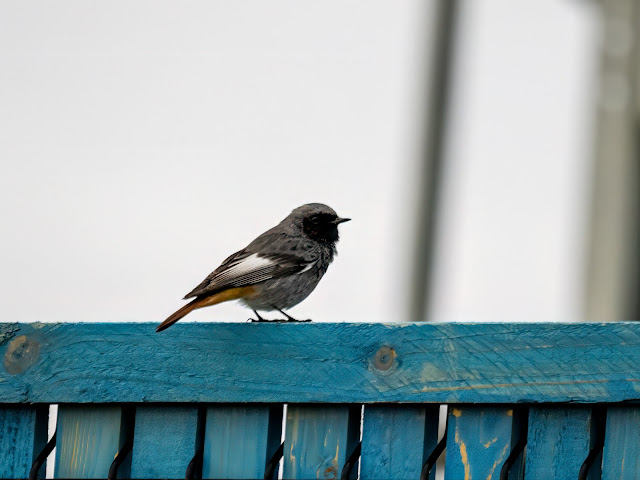I booked a rental car
from 14th to 17th December 2024 for a trip away from home to include
visits to a number of sites in Kent, Suffolk and Norfolk.
My trip provided
excellent birding opportunities including 8 additions to my 2024
UK year list taking it to 205 species, a similar
figure to my 2023 UK year list .
The 8 additions
to my 2023 UK year list were as follows: Long-tailed Duck, Short-eared Owl, Snow Bunting,
Purple Sandpiper, Black Redstart, Brambling, Red-necked Grebe, Slavonian Grebe
During my trip, I
visited the following sites:
RSPB Dungeness, Kent
Elmley National Nature Reserve, Kent
Suffolk Coast National Nature Reserve, Suffolk
Southwold, Suffolk
Ness Point, Lowestoft, Suffolk
Holkham National Nature Reserve, Norfolk
NWT Hickling Broad and Marshes, Norfolk
Flitcham-Anmer area,
Norfolk
RSPB Titchwell Marsh, Norfolk
Saturday 14th December
2024
After picking up my
rental car and driving home, I then drove down to RSPB Dungeness in Kent.
Dungeness is
a headland on the south east coast of Kent formed largely
of a shingle beach in the form of a cuspate foreland. It
shelters a large area of low-lying land, namely Romney Marsh. It
is one of the largest expanses of shingle in Europe and is of international
conservation importance for its geomorphology, plants, invertebrates and
birds. This is recognised and protected mostly through its designations as
a National Nature
Reserve (NNR), a Special Protection Area (SPA), a Special Area of
Conservation (SAC) and part of the Site of Special
Scientific Interest (SSSI) of Dungeness, Romney
Marsh and Rye Bay.
RSPB Dungeness is part of the wider Dungeness area
and comprises a huge area of shingle, freshwater pits, wet and dry
grassland and wildflower meadows. During the winter months, it is particularly
important for large numbers of dabbling and diving ducks plus some of the rarer
grebes and divers.
During my short visit,
I concentrated on scanning the New Diggings pit where a Long-tailed Duck
had been reported for several days.
I eventually had very
distant telescope views of the Long-tailed Duck, the first addition to my
2024 UK year list, plus I also saw a Great Northern Diver and a
Great White Egret.
After my visit to RSPB Dungeness, I drove back north to Elmley National Nature Reserve.
Elmley is the local name for the Isle of Elmley, part
of the Isle of Sheppey in the Swale district of Kent.
Edward Hasted describes in 1798 the isle as 2/8 of the area of the Isle of
Sheppey which is estimated as 11 miles by 8 miles. The present
day National Nature Reserve, designated in 1992, covers more than the
easily traceable area of the former isle by extending to the east over Windmill
Creek, one of two Isle of Sheppey inlets.
In the 1970s a bird
reserve was established on the marshes, the centrepiece of the Elmley National Nature Reserve owned and managed by Elmley Conservation Trust.
Elmley National Nature Reserve covers 3250 acres and is one of the largest nature reserves
in England. It is, at its heart, a family run farm with a long-term vision to
restore nature and a commitment to the sustainability of the landscape and
land.
The vast amount of freshwater
habitat alongside the equally vast expanses of salt marsh and mudflats of the
Swale (a channel of the sea separating the Isle of Sheppey from the mainland)
make the area a gigantic feeding table for waders and wildfowl
throughout the year.
Peak number of waders
and wildfowl arrive between January to March, especially when there is a cold
spell in north west Europe. The grazing marsh is also interspersed with wide
fleets, reed beds, rough grassland strips, hay meadows and 5.6 miles of sea
walls, all of which provide habitats for a variety of terrestrial and aquatic
species.
Conservation and
management efforts on the grazing marshes of Elmley National Nature Reserve are also focused on breeding waders, particularly Lapwing
and Common Redshank.
Elmley National Nature Reserve is also well known as an area for resident and wintering
birds of prey and owls.
By the time I reached Elmley National Nature Reserve, there was insufficient time before dusk for the long walk around the
reserve from Kingshill Farm but the long approach track from the entrance
always provides good opportunities for birding, not least seeing my main target
species for my 2024 UK year list …. Short-eared Owl.
I successfully saw at
least 2 Short-eared Owls hunting over the rough grassland almost at the end
of the track and adjacent to Kingshill Farm.
The highlights from my
visit were as follows: Short-eared Owl (at least 2), Marsh
Harrier (at least 10), Common Buzzard (2), Kestrel (2), Lapwing
(+++), Brown Hare (at least 6)
Photo: Short-eared Owl
Photo: Short-eared Owl
Photo: Short-eared Owl
Photo: Short-eared Owl

Photo: Short-eared Owl
Photo: sunset over the Swale bridge from ElmleySunday 15th December 2024
Early this morning, I drove up to the Suffolk Coast National Nature Reserve.
The Suffolk Coast National Nature Reserve
The Suffolk Coast National Nature Reserve is located on
the North Sea coast of Suffolk around the village of Walberswick and
to the south of the town of Southwold.
The reserve was
designated in 2003, combining the existing Walberswick National Nature
Reserve with reserves at SWT Dingle Marshes and SWT Hen Reedbeds to create a protected area of 3300
acres.
The reserve is managed
by Natural England in conjunction with the RSPB and Suffolk Wildlife Trust. SWT Dingle Marshes is owned jointly by these two
organisations whilst SWT Hen Reedbeds is owned by Suffolk Wildlife Trust. The Walberswick section of the reserve is
largely in private ownership and managed by Natural England. The reserve lies within the Minsmere
to Walberswick Heaths and Marshes Special Areas of Conservation (SAC) and includes areas designated as a Site of Special Scientific Interest (SSSI)
and Natura 2000 and Ramsar sites.
The Walberswick section of the Suffolk Coast National Nature Reserve is the largest at 2950
acres. It contains a range of habitats including reedbed, hay meadows, grazing
marshes, heather and grass heathlands and a variety of mixed and broad-leaved
woodlands. Along the coast shingle banks and beaches, saline lagoons and
intertidal estuary and saltings are also present, providing a range of fresh,
brackish and salt water habitats, whilst the area along the Blyth estuary provides
mudflats and grazing marsh.
The Suffolk Coast National Nature Reserve is a huge area and I visited the area south of Walberswick and walking almost as far as Dunwich.
The main reason for doing so was to try and locate the flock of Snow Buntings that had been reported in the area for some time.
After a very long slog up the shingle beach with absolutely no sign of a single Snow Bunting, I decided to turn round and return to the car park at Walberswick. However, I was in luck as on the way back I did at last see a flock of at least 30 Snow Buntings, another addition to my 2024 UK year list. I spent some time with these very confiding birds and I was able to take many photos.
The highlights from my visit were as follows: Snow Bunting (at least 30), Linnet
(c.20), Greenfinch (c.10), Meadow Pipit (2), Pied Wagtail
(2), Reed Bunting (1), Red-throated Diver (1), Eider (1), Dark-bellied
Brent Goose (1), Great Crested Grebe (1), Mute Swan (3), Teal
(c.20), Mallard (12), Wigeon (7), Gadwall (7), Great
White Egret (1), Little Egret (4), Grey Heron (1), Ringed
Plover (c.30), Common Redshank (c.20), Lapwing (c.15), Dunlin
(7), Spotted Redshank (2), Grey Plover (2), Common Snipe
(1), Turnstone (1), Great Black-backed Gull, Herring Gull, Black-headed Gull
Photo: Snow Bunting
Photo: Snow Bunting
Photo: Snow Bunting
Photo: Snow Bunting
Photo: Snow Bunting
Photo: Snow Bunting
Photo: Snow Bunting

Photo: Snow Bunting
Photo: Snow Bunting
Photo: Snow Bunting
Photo: Snow Buntings

Photo: Snow Bunting
Photo: Snow Bunting
Photo: Snow Bunting
Photo: Snow Bunting
Photo: Snow Bunting
Photo: Snow Bunting
Photo: Snow Buntings
Photo: Snow Bunting

Photo: Snow Bunting
After returning to the car park at Walberswick, I drove a little further north to Southwold and Ness Point, Lowestoft where I had 2 specific target species, Purple Sandpiper at either one or both sites and Black Redstart at the latter.
I was successful in seeing both Purple Sandpiper and Black Redstart, both of which were additions to my 2024 UK year list.
In recent winters, Southwold pier has proved to be more reliable for Purple Sandpipers than the traditional site at Ness Point, Lowestoft and this proved to be the case with an easily found single bird seen foraging with on and around a groyne just north of the pier. Purple Sandpiper is a relatively scarce winter visitor to the UK from their Arctic breeding grounds.
Photo: Purple Sandpiper

Photo: Purple Sandpiper
Photo: Purple Sandpiper
Photo: Purple Sandpiper
Photo: Purple Sandpiper
Photo: Purple Sandpiper
Photo: Purple Sandpiper
Photo: Purple Sandpiper
Photo: Purple Sandpiper
Ness Point, Lowestoft is a coastal industrial area and it has nothing to recommend it scenically although it is significant in being the most easterly point in the UK. It is also well known amongst birders as being a very reliable site (usually) for Purple Sandpipers in winter. However, Black Redstarts are occasionally reported here too and I easily found a male bird feeding from the boundary fencing to the wind turbine.
I stayed overnight at Travelodge Acle.
Sunday 15th December 2024
My first visit of the day was to Holkham National Nature Reserve on the north Norfolk coast and specifically Holkham beach and bay and the freshmarsh either side of Lady Anne’s Drive which runs down to the car park.
Before arriving there, I saw a Red Kite at Cley, 2 Red Kites at Stiffkey and a Red Kite and Common Buzzard near Holkham Hall.
Holkham National Nature Reserve is England's largest National Nature Reserve and it is situated on the Norfolk coast between Burnham Overy Staithe and Blakeney. It is managed by Natural England with the co-operation of the Holkham Estate.
Holkham National Nature Reserve comprises 3900 hectares of a wide range of habitats including grazing marsh, pine woodland, scrub, salt marsh, sand dunes and foreshore.
The reserve is part of the North Norfolk Coast Site of Special Scientific Interest and the larger area is additionally protected through Natura 2000, Special Protection Area and Ramsar listings and it is part of both an Area of Outstanding Natural Beauty and a World Biosphere Reserve.
Holkham National Nature Reserve is a huge area and I accessed the site via Lady Anne’s Drive (opposite the entrance to Holkham Hall) and the Holkham Beach car park.
My visit to Holkham beach and bay and the freshmarsh either side of Lady Anne’s Drive proved to be very productive as I expected it to be. The only disappointment was not seeing any Grey Partridges, a target species for my 2024 UK year list, but it was also surprising not to see any divers or any of the rarer grebes on the sea.
The highlights from my visit were as follows:
Lady Anne’s Drive freshmarsh: Pink-footed Goose (+++++), Greylag Goose (c.15), Wigeon (++++), Teal (++++), Mallard (c.10), Shelduck (2), Moorhen (3), Lapwing (+++), Curlew (6), Common Redshank (2), Red Kite (4), Marsh Harrier (1), Reeves' Muntjac (1)
Holkham woods, beach and sand dunes: Shorelark (5), Skylark (c.15), Meadow Pipit (2), Linnet (5), Red Kite (1), Coal Tit (1 heard calling), Common Redshank (6), Dark-bellied Brent Goose (c.20), Grey Squirrel (1)
Holkham bay (sea): Common Scoter (++++), Red-breasted Merganser (3), Great Crested Grebe (2)
Holkham bay (foreshore): Cormorant (c.50), Sanderling (c.30), Oystercatcher (c.10), Grey Plover (2), Curlew (1), Great Black-backed Gull, Herring Gull, Common Gull
Birds are very distant at Holkham Bay requiring telescope views so I was unable to get any photos.
However, I did get a few photos of birds on or over the freshmarsh on either side of Lady Anne’s Drive.
Photo: Wigeon
Photo: Wigeon

Photo: Wigeon
Photo: Wigeon
Photo: Wigeon
Photo: Teal
Photo: Teal
Photo: Teal
Photo: Marsh Harrier
Photo: Marsh Harrier and Wigeon
Photo: Pink-footed Geese
My day concluded at NWT Hickling Broad and Marshes and specifically the Stubb Mill viewpoint.
NWT Hickling Broad and Marshes is the largest of the Norfolk Broads and is a year-round haven for wildlife and holds a significant percentage of the UK population of Common Crane as well as important breeding numbers of Bittern, Marsh Harrier and Bearded Tit. In winter, large numbers of Marsh Harriers roost in the reedbed north east of Stubb Mill and Hen Harrier, Merlin and Barn Owl can also often be seen. Interesting mammals include the introduced Chinese Water Deer plus Red Deer and Otter.
I spent around 2 hours at the Stubb Mill viewpoint and stayed until it was almost completely dark (a torch is recommended for the long walk back to the car park!).
The highlights from my visit walking to and from the Stubb Mill viewpoint were as follows:
Common Crane (9), Marsh
Harrier (c.35 coming in to roost!), Tawny Owl (male
and female calling from near Stubb Mill and 2 males calling in the lane near
the visitor centre), Pink-footed
Goose (+++), Greylag
Goose (c.20), Cormorant (1), Great White
Egret (1), Lapwing
(c.300), Mallard (c.10), Shelduck
(1), Reeves’
Muntjac (2)
I again stayed overnight at Travelodge Acle.
Monday 16th December 2024
My first visit of the day was to the Flitcham-Anmer area in north west Norfolk. In past years, driving round these farmland lanes has reliably provided sightings of Grey Partridge. This was another target species for my 2024 UK year list which sadly, due its steep decline in numbers, is becoming more and more difficult to locate. Like at Holkham National Nature Reserve the previous day and like my visits to the Flitcham-Anmer area in 2023 and in January 2024, I failed to see a single Grey Partridge.
However, my drive around the area did provide the following highlights: Red Kite (1), Common Buzzard
(2), Kestrel (3), Pink-footed
Goose (c.35), Lapwing
(c.200), Red-legged
Partridge (2), Pheasant
(loads!), Yellowhammer
(1), Redwing (2), Roe Deer (2), Brown Hare (1)
Driving up to the north coast for my visit to RSPB Titchwell Marsh produced a few more notable records: a Red Kite and a calling Common Buzzard at Flitcham, a mixed finch flock of c.100 birds including c.10 Bramblings, Linnets, Chaffinches and Goldfinches between Flitcham and Anmer, a Red Kite and a Common Buzzard between Anmer and Great Bircham and a Red Kite between Choseley Barns and Titchwell. Brambling was another addition to my 2024 UK year list.
The final visit of my trip was to RSPB Titchwell Marsh.
RSPB Titchwell is one of my most visited locations on the north Norfolk coast and it is a very productive site at any time of the year due to the mosaic of habitats including reedbeds, freshwater and saline lagoons, saltmarsh, sandy and shingle foreshore, sand dunes, woodland and grassland. It is an excellent site for breeding birds, passage migrants and winter visitors.
My main target species for this visit were Red-necked Grebe and Slavonian Grebe and I was successful in adding both to my 2024 UK year list, albeit both distant telescope views and a very brief in the case of the latter.
The highlights from my visit were as follows:
Freshmarsh: Dark-bellied Brent
Goose (c.250), Pink-footed Goose (c.50), Greylag Goose (c.30), Little Egret (3), Cormorant (1), Little Grebe (1), Teal (+++), Wigeon (++), Mallard (c.30), Shoveler (c.20), Shelduck (c.10), Gadwall (c.10), Pintail (8), Tufted Duck (4), Goldeneye (2 females), Lapwing (c.200), Golden Plover (c.70), Black-tailed Godwit (c.20), Avocet (5), Curlew (2), Common Redshank (2), Herring Gull, Common Gull, Black-headed Gull, Red Kite (1), Common Buzzard (1), Skylark (c.10), Meadow Pipit (c.5), Reeves' Muntjac (1), Grey Squirrel (1)
Foreshore and sea: Red-necked Grebe (1), Slavonian Grebe (1), Great Crested Grebe (c.10), Common Scoter (c.300), Red-breasted Merganser (c.20), Goldeneye (4 males), Dark-bellied Brent Goose (2), Golden Plover (c100), Dunlin (c.10), Oystercatcher (c.10), Turnstone (c.10), Common Redshank (c.10), Grey Plover (c.5), Bar-tailed Godwit (1)
Photo: Dark-bellied Brent Geese

Photo: Dark-bellied Brent Geese
Photo: Dark-bellied Brent Geese
Photo: Dark-bellied Brent Geese
Photo: Dark-bellied Brent Geese
Photo: Dark-bellied Brent Geese

Photo: Dark-bellied Brent Geese
Photo: Dark-bellied Brent Goose
Photo: Lapwings
Photo: Black-headed Gulls
Photo: Black-headed Gull
Photo: Reeves' MuntjacAfter leaving RSPB Titchwell Marsh and starting the long drive home, I had my final notable sighting of my trip: 8 Cattle Egrets in a field between Titchwell and Holme.
Love nature .... act now
Restore and rewild our natural world
Please help save and enhance our laws that protect our environment and wildlife
💚🦆 🦉🦋🐝🦊🦡🌼 🌳💚
Stay safe, stay well, stay strong, stay connected with nature


































































